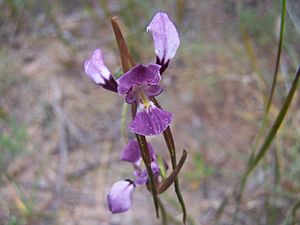Purple donkey orchid facts for kids
Quick facts for kids Purple donkey orchid |
|
|---|---|
 |
|
| Scientific classification | |
| Genus: |
Diuris
|
| Species: |
punctata
|
| Synonyms | |
|
|
The purple donkey orchid (scientific name: Diuris punctata) is a beautiful type of orchid. It grows only in south-eastern Australia, meaning it's endemic there. This orchid has two leaves that look like grass. It can grow up to ten flowers, which are usually purple or light purple. These flowers often have darker spots, and sometimes even yellow marks. There used to be a yellow version of this orchid near Guyra, but it's probably gone forever now.
Contents
What Does the Purple Donkey Orchid Look Like?
The purple donkey orchid is a tuberous plant. This means it has a special underground stem that stores food. It's also a perennial herb, so it lives for more than two years and has soft, green stems.
Leaves and Stems
Each plant has two long, thin leaves. They are about 150–300 mm (6–10 in) long and 3–4 mm (0.1–0.2 in) wide. These leaves are folded lengthwise, like a piece of paper.
The flowers grow on a tall stem. This stem can be anywhere from 300–600 mm (10–20 in) tall. Up to ten flowers can bloom on one stem.
Flower Features
The flowers are usually purple or light purple. They often have darker spots or sometimes yellow marks. Each flower is about 50–60 mm (2.0–2.4 in) wide.
Flower Parts
- The dorsal sepal is the top part of the flower. It stands upright and is shaped like an egg. It measures 10–18 mm (0.4–0.7 in) long and 8–14 mm (0.3–0.6 in) wide.
- The lateral sepals are two greenish-brown parts. They hang downwards and are long and narrow, about 30–50 mm (1–2 in) long.
- The petals stand up tall. They have an egg-shaped blade that is 7–17 mm (0.3–0.7 in) long. These petals sit on a dark stalk.
- The labellum is a special lip-like part of the orchid. It is 9–15 mm (0.4–0.6 in) long and has three sections. The middle section is wide and fan-shaped. The two side sections are smaller and narrow.
- There are also two small, ridge-like bumps called calli on the labellum. They are about 5 mm (0.2 in) long and are surrounded by yellow.
The purple donkey orchid usually flowers from September to December.
How the Purple Donkey Orchid Got Its Name
The scientific name for this orchid is Diuris punctata. It was first officially described in 1804 by a botanist named James Edward Smith.
The second part of its name, punctata, comes from a Latin word. It means "spotted" or "dotted." This name fits well because the flowers often have darker spots!
Where Does the Purple Donkey Orchid Live?
The purple donkey orchid grows in south-eastern Australia. You can find it in New South Wales, the Australian Capital Territory, and Victoria. It likes to grow in forests and open grasslands.
In New South Wales, it grows south of the Moonbi Range. In Victoria, it's found north of the Mornington Peninsula.
There was once a special yellow type of this orchid. It was called Diuris punctata var. sulfurea. This yellow form was found near Guyra, but sadly, it is now thought to be extinct. This means it no longer exists anywhere in the world.
Protecting the Purple Donkey Orchid
The purple donkey orchid is considered "threatened" in Victoria. This means it's at risk of disappearing if we don't protect it. It's listed under a law called the Flora and Fauna Guarantee Act 1988.
Main Threats to the Orchid
- Weeds and Grasses: Other plants, like weeds and grasses, can grow too close to the orchids. They compete for sunlight, water, and nutrients, making it hard for the orchids to thrive.
- Grazing: Animals eating the orchids can also harm them.
- Soil Disturbance: When the soil is moved or changed, it can damage the orchid's roots and tubers. This can happen from farming, building, or other human activities.
By understanding these threats, people can work to protect this beautiful and unique Australian orchid.

